Towards Understanding and Sustaining Natural Resource Systems through the Systems Perspective: A Systematic Evaluation
Abstract
1. Introduction
2. Conceptual Understandings
2.1. Bibliometric Analysis Approach
2.2. Systems Thinking and System Dynamics Approach
3. Material and Methods
3.1. Data Retrieval
3.2. Data Processing and Analysis
4. Results and Discussion
5. Application of Systems Thinking to Policy Discourse
6. Conclusions
Author Contributions
Funding
Acknowledgments
Conflicts of Interest
References
- Dyball, R.; Newell, B. Understanding Human Ecology. Underst. Hum. Ecol. 2014. [Google Scholar] [CrossRef]
- Liu, J.; Mooney, H.A.; Hull, V.; Davis, S.J.; Gaskell, J.; Hertel, T.W.; Lubchenco, J.; Seto, K.C.; Gleick, P.H.; Kremen, C.; et al. Systems integration for global sustainability. Science 2015, 347, 1258832. [Google Scholar] [CrossRef]
- Cui, X.; Fang, C.; Liu, H.; Liu, X. Assessing sustainability of urbanization by a coordinated development index for an Urbanization-Resources-Environment complex system: A case study of Jing-Jin-Ji region, China. Ecol. Indic. 2019, 96, 383–391. [Google Scholar] [CrossRef]
- Haberl, H.; Wiedenhofer, D.; Pauliuk, S.; Krausmann, F.; Müller, D.B.; Fischer-Kowalski, M. Contributions of sociometabolic research to sustainability science. Nat. Sustain. 2019, 2, 173–184. [Google Scholar] [CrossRef]
- Sterman, J.D. Sustaining Sustainability: Creating a Systems Science in a Fragmented Academy and Polarized World; Springer: New York, NY, USA, 2012; pp. 21–58. [Google Scholar]
- Levin, S.; Xepapadeas, T.; Crépin, A.-S.; Norberg, J.; De Zeeuw, A.; Folke, C.; Hughes, T.P.; Arrow, K.J.; Barrett, S.; Daily, G.C.; et al. Social-ecological systems as complex adaptive systems: Modeling and policy implications. Environ. Dev. Econ. 2013, 18, 111–132. [Google Scholar] [CrossRef]
- Fan, S.; Brzeska, J. Feeding More People on an Increasingly Fragile Planet: China’s Food and Nutrition Security in a National and Global Context. J. Integr. Agric. 2014, 13, 1193–1205. [Google Scholar] [CrossRef]
- Henry, R.C.; Engstrom, K.; Olin, S.; Alexander, P.; Arneth, A.; Rounsevell, M.D.A. Food supply and bioenergy production within the global cropland planetary boundary. PLoS ONE 2018, 13, e0194695. [Google Scholar] [CrossRef]
- Nilsson, M.; Griggs, D.; Visbeck, M. Policy: Map the interactions between Sustainable Development Goals. Nat. Cell Biol. 2016, 534, 320–322. [Google Scholar] [CrossRef]
- Stafford-Smith, M.; Griggs, D.; Gaffney, O.; Ullah, F.; Reyers, B.; Kanie, N.; Stigson, B.; Shrivastava, P.; Leach, M.; O’Connell, D. Integration: The key to implementing the Sustainable Development Goals. Sustain. Sci. 2017, 12, 911–919. [Google Scholar] [CrossRef] [PubMed]
- Sachs, J.D.; Schmidt-Traub, G.; Mazzucato, M.; Messner, D.; Nakicenovic, N.; Rockström, J. Six Transformations to achieve the Sustainable Development Goals. Nat. Sustain. 2019, 2, 805–814. [Google Scholar] [CrossRef]
- Senge, P.M. The Fifth Discipline: The Art and Practice of The Learning Organization; [Kindle Paperwhite Edition]; Performance Instruction; Broadway Business: New York, NY, USA, 2006; Volume 30. [Google Scholar]
- Richmond, B. Systems thinking/system dynamics: Let’s just get on with it. Syst. Dyn. Rev. 1994, 10, 135–157. [Google Scholar] [CrossRef]
- Wolstenholme, E.F. Towards the definition and use of a core set of archetypal structures in system dynamics. Syst. Dyn. Rev. 2003, 19, 7–26. [Google Scholar] [CrossRef]
- Gallopín, G.C. Linkages between vulnerability, resilience, and adaptive capacity. Glob. Environ. Chang. 2006, 16, 293–303. [Google Scholar] [CrossRef]
- Barbier, E.B.; Burgess, J.C. The Sustainable Development Goals and the systems approach to sustainability. Econ. Open-Access Open-Assess. E-J. 2017, 11. [Google Scholar] [CrossRef]
- Zare, F.; ElSawah, S.; Bagheri, A.; Nabavi, E.; Jakeman, A. Improved integrated water resource modelling by combining DPSIR and system dynamics conceptual modelling techniques. J. Environ. Manag. 2019, 246, 27–41. [Google Scholar] [CrossRef]
- Di Marco, M.; Baker, M.L.; Daszak, P.; De Barro, P.; Eskew, E.A.; Godde, C.M.; Harwood, T.D.; Herrero, M.; Hoskins, A.J.; Johnson, E.; et al. Opinion: Sustainable development must account for pandemic risk. Proc. Natl. Acad. Sci. USA 2020, 117, 3888–3892. [Google Scholar]
- Forrester, J.W. Industrial Dynamics. J. Oper. Res. Soc. 1997, 48, 1148. [Google Scholar]
- Coyle, G. Qualitative and quantitative modelling in system dynamics: Some research questions. Syst. Dyn. Rev. 2000, 16, 244. [Google Scholar]
- Sterman, J.D. System Dynamics Modeling: Tools for Learning in a Complex World. Calif. Manag. Rev. 2001, 43, 8–25. [Google Scholar] [CrossRef]
- Saviano, M.; Barile, S.; Farioli, F.; Orecchini, F. Strengthening the science–policy–industry interface for progressing toward sustainability: A systems thinking view. Sustain. Sci. 2019, 14, 1549–1564. [Google Scholar] [CrossRef]
- Kotir, J.H.; Brown, G.; Marshall, N.; Johnstone, R. Systemic feedback modelling for sustainable water resources management and agricultural development: An application of participatory modelling approach in the Volta River Basin. Environ. Model. Softw. 2017, 88, 106–118. [Google Scholar] [CrossRef]
- Amadei, B. Revisiting positive peace using systems tools. Technol. Soc. Chang. 2020, 158, 120149. [Google Scholar] [CrossRef]
- Hossain, N.U.I.; Dayarathna, V.L.; Nagahi, M.; Jaradat, R. Systems Thinking: A Review and Bibliometric Analysis. Systems 2020, 8, 23. [Google Scholar] [CrossRef]
- Pritchard, A. Statistical Bibliography or Bibliometrics? J. Doc. 1969, 25, 348–349. [Google Scholar]
- Hood, W.W.; Wilson, C.S. The Literature of Bibliometrics, Scientometrics, and Informetrics. Science 2001, 52, 291–314. [Google Scholar] [CrossRef]
- Khiste, G.P.; Dnyaneshwar, B.M. Big Data Output in J-gate during 2013 to 2017: A Bibliometrics Analysis. Int. J. Sci. Res. Comput. Sci. 2018, 3, 2456–3307. Available online: https://www.researchgate.net/profile/Gajanan_Khiste/publication/323291547_Big_Data_Output_in_J-gate_during_2013_to_2017_A_Bibliometrics_Analysis/links/5a8c52bc458515a4068ad605/Big-Data-Output-in-J-gate-during-2013-to-2017-A-Bibliometrics-Analysis.pdf (accessed on 3 August 2020).
- Fahimnia, B.; Sarkis, J.; Davarzani, H. Green supply chain management: A review and bibliometric analysis. Int. J. Prod. Econ. 2015, 162, 101–114. [Google Scholar]
- Rialti, R.; Marzi, G.; Ciappei, C.; Busso, D. Big data and dynamic capabilities: A bibliometric analysis and systematic literature review. Manag. Decis. 2019, 57, 2052–2068. [Google Scholar] [CrossRef]
- Orimoloye, I.; Ololade, O.O. Potential implications of gold-mining activities on some environmental components: A global assessment (1990 to 2018). J. King Saud Univ. Sci. 2020, 32, 2432–2438. [Google Scholar] [CrossRef]
- Orimoloye, I.R.; Belle, J.A.; Ololade, O.O. Exploring the emerging evolution trends of disaster risk reduction research: A global scenario. Int. J. Environ. Sci. Technol. 2020, 1–18. [Google Scholar] [CrossRef]
- Khiste, G.P.; Paithankar, R.R. Analysis of Bibliometric Term in Scopus. Int. J. Libr. Inf. Sci. 2017, 3, 81–88. [Google Scholar]
- Reis, T.L.; Mathias, M.A.; De Oliveira, O.J. Maturity models: Identifying the state-of-the-art and the scientific gaps from a bibliometric study. Science 2016, 110, 643–672. [Google Scholar] [CrossRef]
- Broadus, R.N. Toward a definition of “bibliometrics”. Science 1987, 12, 373–379. [Google Scholar] [CrossRef]
- Ruhanen, L.; Weiler, B.; Moyle, B.D.; McLennan, C.-L.J. Trends and patterns in sustainable tourism research: A 25-year bibliometric analysis. J. Sustain. Tour. 2015, 23, 517–535. [Google Scholar] [CrossRef]
- Wang, Y.; Lai, N.; Zuo, J.; Chen, G.; Du, H. Characteristics and trends of research on waste-to-energy incineration: A bibliometric analysis, 1999–2015. Renew. Sustain. Energy Rev. 2016, 66, 95–104. [Google Scholar] [CrossRef]
- Sanchez-Azanza, V.A.; López-Penadés, R.; Buil-Legaz, L.; Aguilar-Mediavilla, E.; Adrover-Roig, D. Is bilingualism losing its advantage? A bibliometric approach. PLoS ONE 2017, 12, e0176151. [Google Scholar] [CrossRef]
- Persson, O.; Danell, R.; Schneider, J.W. Celebrating scholarly communication studies: A Festschrift for Olle Persson at his 60th Birthday. In How to use Bibexcel for Various Types of Bibliometric Analysis; Umeå University: Umeå, Sweden, 2009. [Google Scholar]
- Mishra, D.; Gunasekaran, A.; Papadopoulos, T.; Childe, S.J. Big Data and supply chain management: A review and bibliometric analysis. Ann. Oper. Res. 2018, 270, 313–336. [Google Scholar] [CrossRef]
- Von Bertalanffy, L.; Sutherland, J.W. General Systems Theory: Foundations, Developments, Applications. IEEE Trans. Syst. Man Cybern. 1974, 4, 592. [Google Scholar]
- Turner, J.R.; Baker, R. Complexity Theory: An Overview with Potential Applications for the Social Sciences. Systems 2019, 7, 4. [Google Scholar] [CrossRef]
- Bosch, O.J.H.; King, C.A.; Herbohn, J.L.; Russell, I.W.; Smith, C.S. Getting the big picture in natural resource management-systems thinking as ‘method’ for scientists, policy makers and other stakeholders. Syst. Res. Behav. Sci. 2007, 24, 217–232. [Google Scholar] [CrossRef]
- Cabrera, D.; Cabrera, L.; Powers, E.; Solin, J.; Kushner, J. Applying systems thinking models of organizational design and change in community operational research. Eur. J. Oper. Res. 2018, 268, 932–945. [Google Scholar] [CrossRef]
- Bosch, O.J.H.; Nguyen, N.C.; Maeno, T.; Yasui, T. Managing Complex Issues through Evolutionary Learning Laboratories. Syst. Res. Behav. Sci. 2013, 30, 116–135. [Google Scholar] [CrossRef]
- Dekker, S. Drift into Failure: From Hunting Broken Components to Understanding Complex Systems; CRC Press: Boca Raton, FL, USA, 2012. [Google Scholar]
- Crawford, T.W.; Messina, J.P.; Manson, S.M.; O’Sullivan, D. Complexity science, complex systems, and land-use research. Environ. Plan. B Plan. Des. 2005, 32, 792–798. [Google Scholar] [CrossRef]
- Lemke, J.L.; Sabelli, N.H. Complex Systems and Educational Change: Towards a new research agenda. Educ. Philos. Theory 2008, 40, 118–129. [Google Scholar] [CrossRef]
- Checkland, P. Systems thinking, systems practice: Includes a 30-year retrospective. J. Oper. Res. Soc. 2000, 51, 647. [Google Scholar]
- Sterman, J. Systems dynamics modeling: Tools for learning in a complex world. IEEE Eng. Manag. Rev. 2002, 30, 42. [Google Scholar] [CrossRef]
- Nguyen, N.C.; Bosch, O.J.H. A Systems Thinking Approach to identify Leverage Points for Sustainability: A Case Study in the Cat Ba Biosphere Reserve, Vietnam. Syst. Res. Behav. Sci. 2013, 30, 104–115. [Google Scholar] [CrossRef]
- Schaffernicht, M. Causal loop diagrams between structure and behaviour: A critical analysis of the relationship between polarity, behaviour and events. Syst. Res. Behav. Sci. 2010, 27, 653–666. [Google Scholar] [CrossRef]
- Kotir, J.H. Managing and Sustaining the Coupled Water-Land-Food Systems in the Context of Global Change: How Qualitative System Dynamic Modelling Can Assist in Understanding and Designing High-Leverage Interventions. In Natural Resources Management and Biological Sciences; IntechOpen: London, UK, 2020. [Google Scholar]
- Mirchi, A.; Madani, K.; Watkins, D.W.; Ahmad, S. Synthesis of System Dynamics Tools for Holistic Conceptualization of Water Resources Problems. Water Resour. Manag. 2012, 26, 2421–2442. [Google Scholar] [CrossRef]
- Walters, J.P.; Archer, D.W.; Sassenrath, G.F.; Hendrickson, J.R.; Hanson, J.D.; Halloran, J.M.; Vadas, P.A.; Alarcon, V.J. Exploring agricultural production systems and their fundamental components with system dynamics modelling. Ecol. Model. 2016, 333, 51–65. [Google Scholar] [CrossRef]
- Khan, S.; Yufeng, L.; Ahmad, A. Analysing complex behaviour of hydrological systems through a system dynamics approach. Environ. Model. Softw. 2009, 24, 1363–1372. [Google Scholar] [CrossRef]
- Azar, A.T. System dynamics as a useful technique for complex systems. Int. J. Ind. Syst. Eng. 2012, 10, 377. [Google Scholar] [CrossRef]
- Kiani, B.; Shirouyehzad, H.; Bafti, F.K.; Fouladgar, H. System dynamics approach to analysing the cost factors effects on cost of quality. Int. J. Qual. Reliab. Manag. 2009, 26, 685–698. [Google Scholar] [CrossRef]
- Aslani, A.; Helo, P.; Naaranoja, M. Role of renewable energy policies in energy dependency in Finland: System dynamics approach. Appl. Energy 2014, 113, 758–765. [Google Scholar] [CrossRef]
- Coyle, R.G. System Dynamics Modelling: A Practical Approach. J. Oper. Res. Soc. 1997, 48, 544. [Google Scholar]
- Zhan, S.; Zhang, X.; Ma, C.; Chen, W. Dynamic modelling for ecological and economic sustainability in a rapid urbanizing region. Procedia Environ. Sci. 2012, 13, 242–251. [Google Scholar] [CrossRef]
- Turner, B.L.; Menendez, H.M.; Gates, R.N.; O Tedeschi, L.; Atzori, A.S. System Dynamics Modeling for Agricultural and Natural Resource Management Issues: Review of Some Past Cases and Forecasting Future Roles. Resources 2016, 5, 40. [Google Scholar] [CrossRef]
- Anand, S.; Vrat, P.; Dahiya, R. Application of a system dynamics approach for assessment and mitigation of CO2 emissions from the cement industry. J. Environ. Manag. 2006, 79, 383–398. [Google Scholar] [CrossRef]
- Wu, Z.; Xu, J. Predicting and optimization of energy consumption using system dynamics-fuzzy multiple objective programming in world heritage areas. Energy 2013, 49, 19–31. [Google Scholar] [CrossRef]
- Chapman, A.; Darby, S. Evaluating sustainable adaptation strategies for vulnerable mega-deltas using system dynamics modelling: Rice agriculture in the Mekong Delta’s an Giang Province, Vietnam. Sci. Total. Environ. 2016, 559, 326–338. [Google Scholar] [CrossRef]
- Davila, F.; Dyball, R.; Amparo, J.M. Transdisciplinary research for food and nutrition security: Examining research-policy understandings in Southeast Asia. Environ. Dev. 2018, 28, 67–82. [Google Scholar] [CrossRef]
- Pasqualino, R.; Monasterolo, I.; Jones, A. An Integrated Global Food and Energy Security System Dynamics Model for Addressing Systemic Risk. Sustainability 2019, 11, 3995. [Google Scholar] [CrossRef]
- Inam, A.; Adamowski, J.; Halbe, J.; Prasher, S. Using causal loop diagrams for the initialization of stakeholder engagement in soil salinity management in agricultural watersheds in developing countries: A case study in the Rechna Doab watershed, Pakistan. J. Environ. Manag. 2015, 152, 251–267. [Google Scholar] [CrossRef]
- Kotir, J.H.; Smith, C.; Brown, G.; Marshall, N.; Johnstone, R. A system dynamics simulation model for sustainable water resources management and agricultural development in the Volta River Basin, Ghana. Sci. Total. Environ. 2016, 573, 444–457. [Google Scholar] [CrossRef] [PubMed]
- Pluchinotta, I.; Pagano, A.; Giordano, R.; Tsoukiàs, A. A system dynamics model for supporting decision-makers in irrigation water management. J. Environ. Manag. 2018, 223, 815–824. [Google Scholar] [CrossRef]
- Purwanto, A.; Sušnik, J.; Suryadi, F.; De Fraiture, C. Using group model building to develop a causal loop mapping of the water-energy-food security nexus in Karawang Regency, Indonesia. J. Clean. Prod. 2019, 240, 118170. [Google Scholar] [CrossRef]
- Halog, A.; Manik, Y. Advancing Integrated Systems Modelling Framework for Life Cycle Sustainability Assessment. Sustainability 2011, 3, 469–499. [Google Scholar] [CrossRef]
- Mendoza, G.A.; Prabhu, R. Combining participatory modeling and multi-criteria analysis for community-based forest management. Ecol. Manag. 2005, 207, 145–156. [Google Scholar] [CrossRef]
- Wang, X.-J.; Zhang, J.; Liu, J.; Wang, G.; He, R.; Elmahdi, A.; ElSawah, S. Water resources planning and management based on system dynamics: A case study of Yulin city. Environ. Dev. Sustain. 2010, 13, 331–351. [Google Scholar] [CrossRef]
- Lienert, M.; Lochner, S. The importance of market interdependencies in modeling energy systems—The case of the European electricity generation market. Int. J. Electr. Power Energy Syst. 2012, 34, 99–113. [Google Scholar] [CrossRef]
- Ormazabal, M.; Sarriegi, J.M. Environmental management: Understanding its evolution through maturity states. Environ. Qual. Manag. 2012, 22, 31–42. [Google Scholar] [CrossRef]
- Bérard, C.; Cloutier, L.M.; Cassivi, L. The effects of using system dynamics-based decision support models: Testing policy-makers’ boundaries in a complex situation. J. Decis. Syst. 2016, 26, 45–63. [Google Scholar] [CrossRef]
- Sterman, J. All models are wrong: Reflections on becoming a systems scientist. Syst. Dyn. Rev. 2002, 18, 501–531. [Google Scholar] [CrossRef]
- Aleixandre-Benavent, R.; Aleixandre-Tudó, J.L.; Castelló-Cogollos, L.; Aleixandre, J.L. Trends in scientific research on climate change in agriculture and forestry subject areas (2005–2014). J. Clean. Prod. 2017, 147, 406–418. [Google Scholar]
- Sweileh, W.M.; Wickramage, K.; Pottie, K.; Hui, C.; Roberts, B.; Sawalha, A.F.; Zyoud, S.H. Bibliometric analysis of global migration health research in peer-reviewed literature (2000–2016). BMC Public Health 2018, 18, 1–18. [Google Scholar] [CrossRef]
- Ekundayo, T.C.; Okoh, A.I. A global bibliometric analysis of Plesiomonas-related research (1990–2017). PLoS ONE 2018, 13, e0207655. [Google Scholar]
- Orimoloye, I.R.; Ololade, O.O. Global trends assessment of environmental health degradation studies from 1990 to 2018. Environ. Dev. Sustain. 2020, 1–14. [Google Scholar] [CrossRef]
- Morecroft, J.D.W. Strategic Modelling and Business Dynamics: A Feedback Systems Approach, 2nd ed.; Wiley & Sons: West Sussex, UK, 2015. [Google Scholar]
- Nyam, Y.S.; Kotir, J.H.; Jordaan, A.J.; Ogundeji, A.A.; Turton, A.R. Drivers of change in sustainable water management and agricultural development in South Africa: A participatory approach. Sustain. Water Resour. Manag. 2020, 6, 1–20. [Google Scholar] [CrossRef]
- Mishra, D.; Zongwei, L.; Jiang, S.; Papadopoulos, T.; Dubey, R. A bibliographic study on big data: Concepts, trends and challenges. Bus. Process. Manag. J. 2017, 23, 555–573. [Google Scholar] [CrossRef]
- Chughtai, S.; Blanchet, K. Systems thinking in public health: A bibliographic contribution to a meta-narrative review. Health Policy Plan. 2017, 32, 585–594. [Google Scholar] [CrossRef]
- MacRoberts, M.; MacRoberts, B. Problems of citation analysis: A study of uncited and seldom-cited influences. J. Am. Soc. Inf. Sci. Technol. 2010, 61, 1–12. [Google Scholar] [CrossRef]
- Feng, Y.; Chen, S.; Zhang, L. System dynamics modeling for urban energy consumption and CO2 emissions: A case study of Beijing, China. Ecol. Model. 2013, 252, 44–52. [Google Scholar] [CrossRef]
- Simonovic, S.P.; Fahmy, H.; El-Shorbagy, A. The Use of Object-Oriented Modeling for Water Resources Planning in Egypt. Water Resour. Manag. 1997, 11, 243–261. [Google Scholar] [CrossRef]
- Daré, W.; Venot, J.-P.; Le Page, C.; Aduna, A. Problemshed or Watershed? Participatory Modeling towards IWRM in North Ghana. Water 2018, 10, 721. [Google Scholar] [CrossRef]
- Zhang, L.; Wang, M.-H.; Hu, J.; Ho, Y.-S. A review of published wetland research, 1991–2008: Ecological engineering and ecosystem restoration. Ecol. Eng. 2010, 36, 973–980. [Google Scholar] [CrossRef]
- Hirsch, J.E. An index to quantify an individual’s scientific research output. Proc. Natl. Acad. Sci. USA 2005, 102, 16569–16572. [Google Scholar] [CrossRef]
- Xu, Z.; Takeuchi, K.; Ishidaira, H.; Zhang, X.W. Sustainability Analysis for Yellow River Water Resources Using the System Dynamics Approach. Water Resour. Manag. 2002, 16, 239–261. [Google Scholar] [CrossRef]
- Leydesdorff, L. How are new citation-based journal indicators adding to the bibliometric toolbox? J. Am. Soc. Inf. Sci. Technol. 2009, 60, 1327–1336. [Google Scholar] [CrossRef]
- Winz, I.; Brierley, G.; Trowsdale, S. The Use of System Dynamics Simulation in Water Resources Management. Water Resour. Manag. 2008, 23, 1301–1323. [Google Scholar] [CrossRef]
- Barlas, Y. Formal aspects of model validity and validation in system dynamics. Syst. Dyn. Rev. 1996, 12, 183–210. [Google Scholar]
- Stave, K. A system dynamics model to facilitate public understanding of water management options in Las Vegas, Nevada. J. Environ. Manag. 2003, 67, 303–313. [Google Scholar] [CrossRef]
- Laniak, G.F.; Olchin, G.; Goodall, J.; Voinov, A.; Hill, M.; Glynn, P.; Whelan, G.; Geller, G.; Quinn, N.; Blind, M.; et al. Integrated environmental modeling: A vision and roadmap for the future. Environ. Model. Softw. 2013, 39, 3–23. [Google Scholar] [CrossRef]
- Chapman, J. System Failure—Why Governments Must Learn to think Differently, 2nd ed.; Demos Report; Demos: London, UK, 2004. [Google Scholar]
- Stroh, D.P. Systems Thinking for Social Change; A Practical Guide to Solving Complex Problems, Avoiding Unintended Consequences, and Achieving Lasting Results. Systems Thinking for Social Change; Chelsea Green Publishing: White River Junction, VT, USA, 2015. [Google Scholar]
- Bahri, M. Analysis of the water, energy, food and land nexus using the system archetypes: A case study in the Jatiluhur reservoir, West Java, Indonesia. Sci. Total. Environ. 2020, 716, 137025. [Google Scholar] [CrossRef] [PubMed]

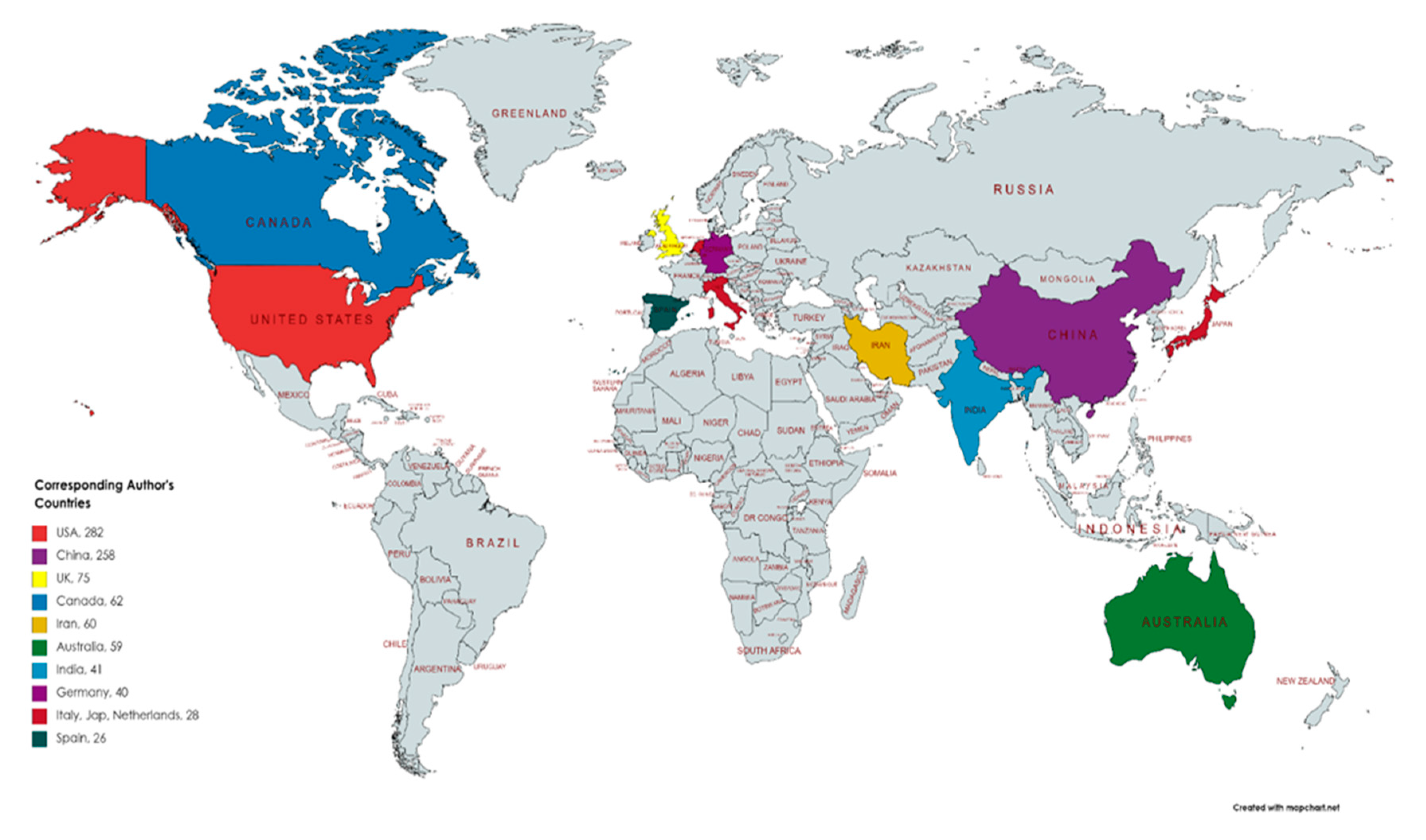
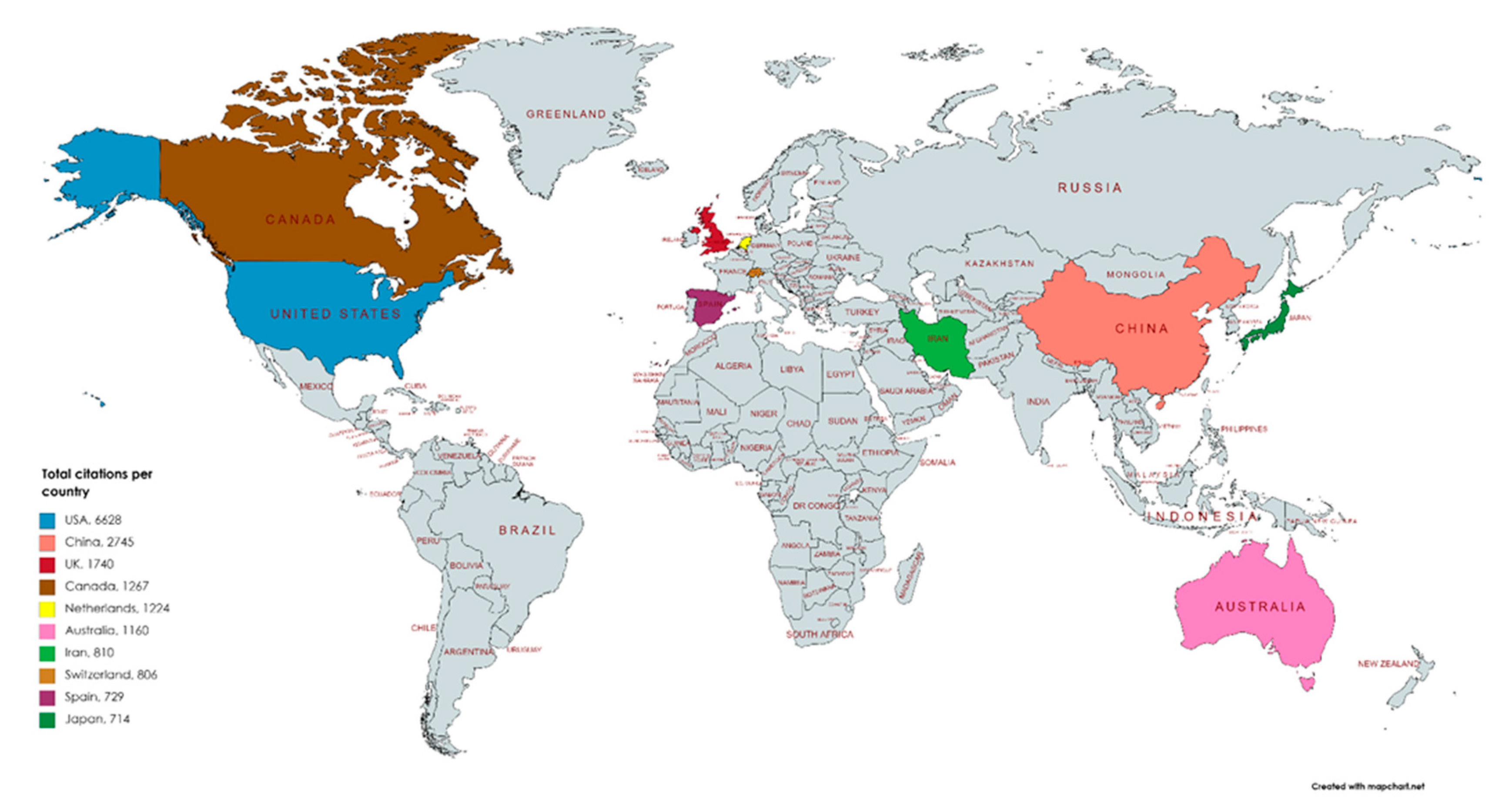
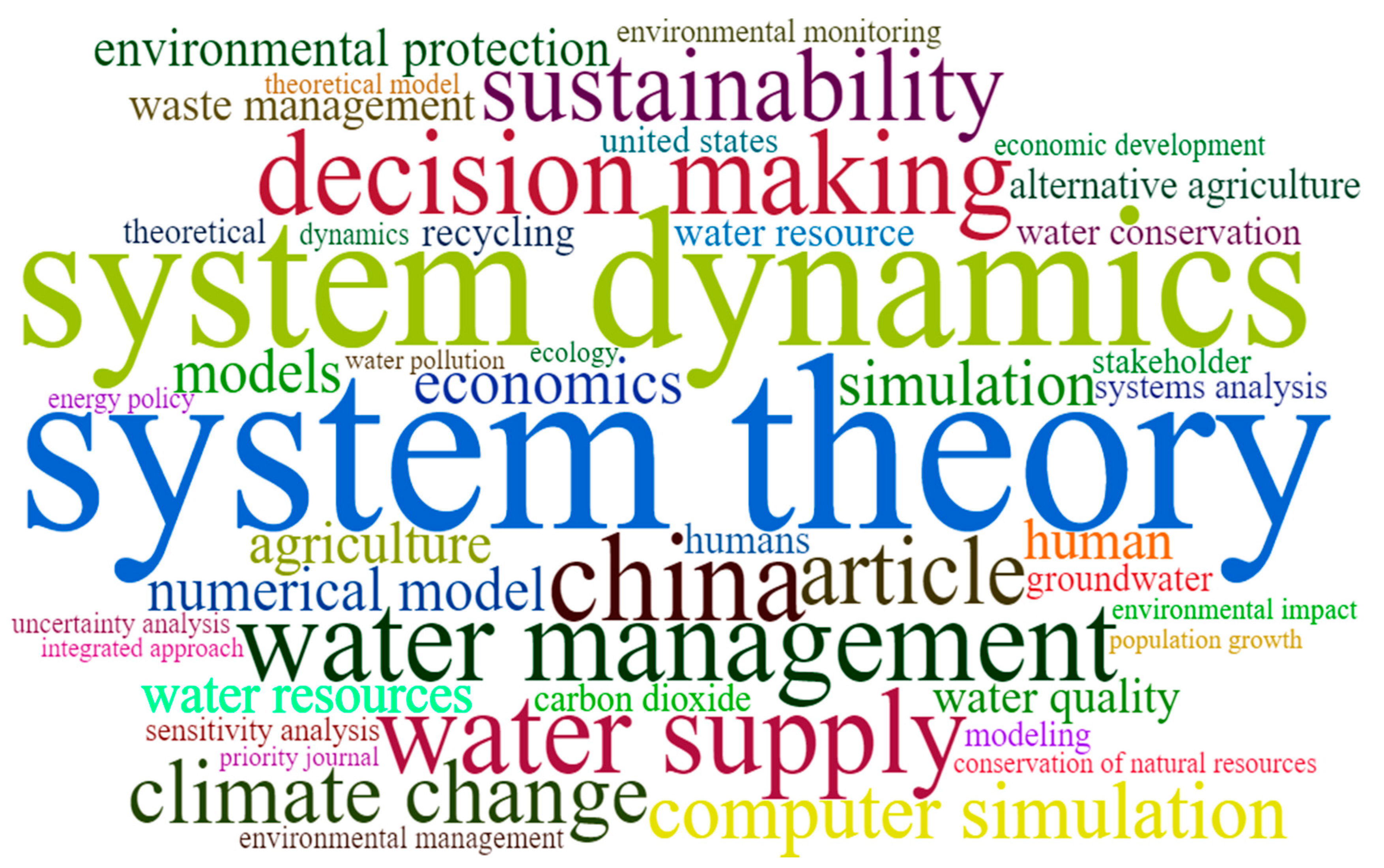
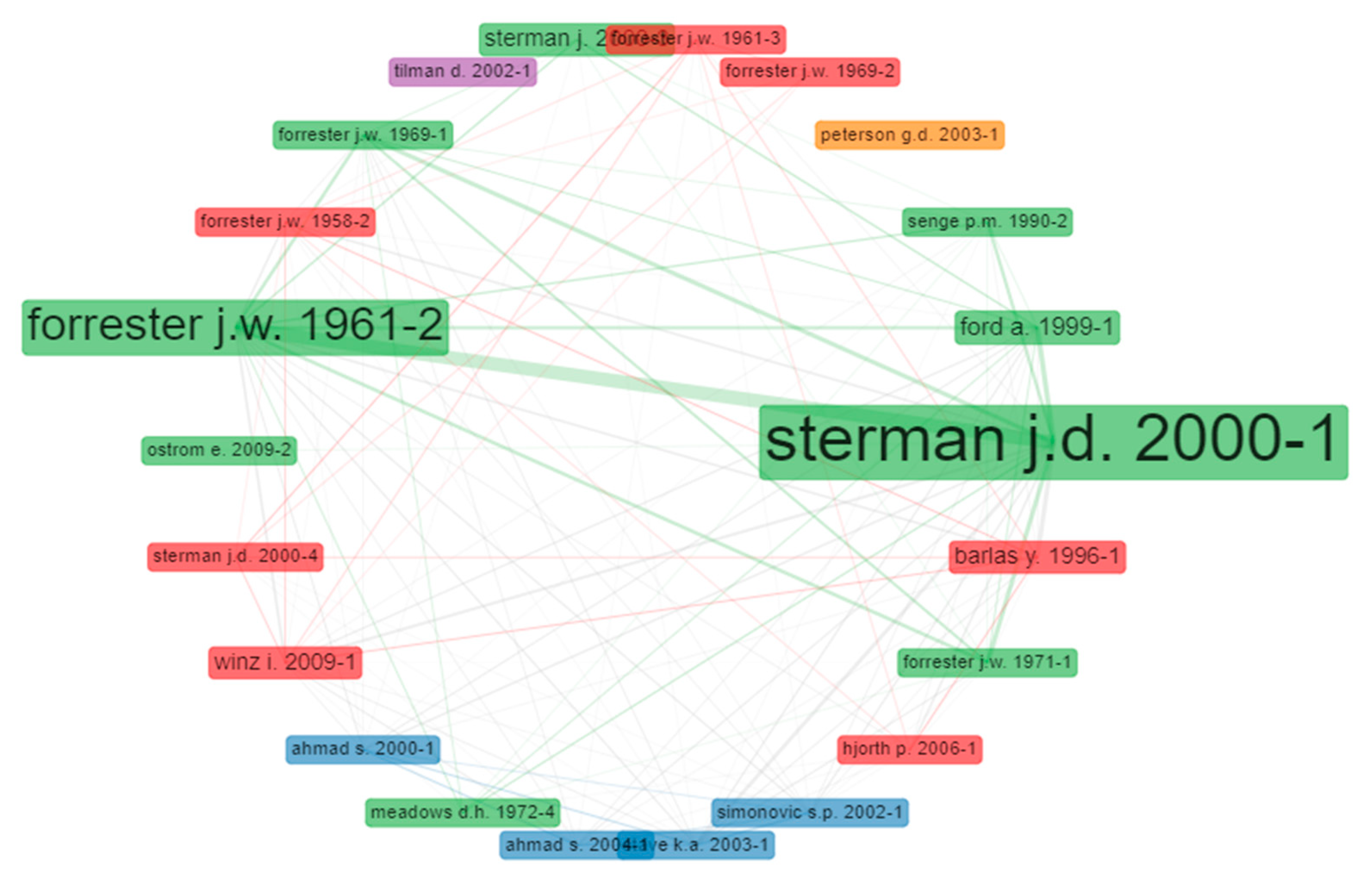
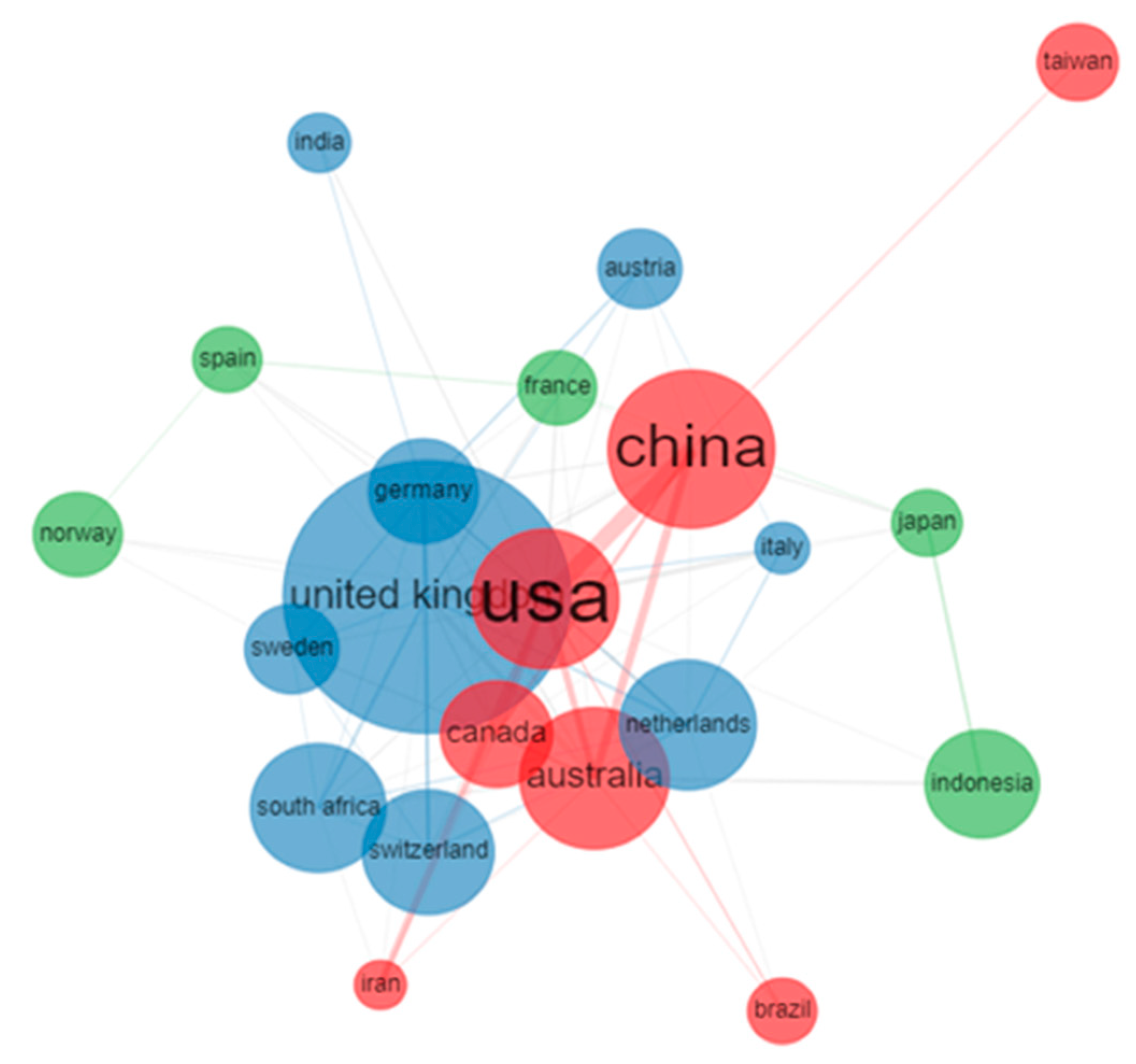
| Content Analyzed | Stats |
|---|---|
| Documents | 1674 |
| Sources (Journals, Books, etc.) | 715 |
| Keywords Plus (ID) | 5757 |
| Author’s Keywords (DE) | 3931 |
| Period | 1981–2019 |
| Average citations per documents | 15.67 |
| Authors | 4277 |
| Author Appearances | 5782 |
| Authors of single-authored documents | 228 |
| Authors of multi-authored documents | 4049 |
| Single-authored documents | 250 |
| Documents per Author | 0.391 |
| Authors per Document | 2.55 |
| Co-Authors per Documents | 3.45 |
| Collaboration Index | 2.84 |
| Document Types | |
| Article | 1276 |
| Article, Early Access | 3 |
| Article, Proceedings Paper | 40 |
| Book | 9 |
| Book Chapter | 82 |
| Book Review | 12 |
| Conference Paper | 168 |
| Conference Review | 1 |
| Meeting Abstract | 7 |
| Review | 76 |
| Author | Year | Title | Sources | DOI | TC | TCpY |
|---|---|---|---|---|---|---|
| Feng Y. | 2013 | System dynamics modeling for urban energy consumption and CO2 emissions: A case study of Beijing, China | Ecological Modelling | 10.1016/J.ECOLMODEL.2012.09.008 | 223 | 27.875 |
| Zhang X | 2002 | Sustainability analysis for Yellow River water resources using the system dynamics approach | Water Resources Management | 10.1023/A:1020206826669 | 141 | 7.421 |
| Mirchi A | 2012 | Synthesis of system dynamics tools for holistic conceptualization of water resources problems | Water Resource Management | 10.1007/s11269-012-0024-2 | 123 | 15.375 |
| Simonovic | 2002 | System dynamics model for predicting floods from snowmelt in North American prairie watersheds | Hydrological Processes | 10.1002/HYP.1064 | 96 | 5.052 |
| Wang Y | 2014 | Impact of subsidy policies on recycling and remanufacturing using system dynamics methodology: a case of auto parts in China | Journal Of Cleaner Production | 10.1016/J.JCLEPRO.2014.03.023 | 88 | 12.571 |
| Huang Y | 2012 | Optimization of the irrigation water resources for agricultural sustainability in Tarim River Basin, China | Agricultural Water Management | 10.1016/J.AGWAT.2012.01.012 | 81 | 9 |
| Ansari N. | 2013 | A system dynamics model for analyzing energy consumption and CO2 emission in the Iranian cement industry under various production and export scenarios | Energy Policy | 10.1016/J.ENPOL.2013.02.042 | 50 | 5 |
| Liu J | 2008 | A system dynamics model for analyzing energy consumption and CO2 emission in Iranian cement industry under various production and export scenarios | Ground Water | 10.1111/J.1745-6584.2008.00486.X | 74 | 5.693 |
| Li X | 2013 | Combining system dynamics and hybrid particle swarm optimization for land use allocation | Ecological Modelling | 10.1016/J.ECOLMODEL.2013.02.027 | 65 | 8.125 |
| Zhang L | 2015 | How might China achieve its 2020 emissions target? A scenario analysis of energy consumption and CO2 emissions using the system dynamics model | Journal of Cleaner Production | 10.1016/J.JCLEPRO.2014.12.080 | 63 | 10.5 |
| Source | H_index | TC | NP | PY_start |
|---|---|---|---|---|
| Journal of Cleaner Production | 20 | 1634 | 67 | 1999 |
| Sustainability (Switzerland) | 10 | 396 | 65 | 2014 |
| Energy Policy | 18 | 838 | 29 | 1992 |
| Ecological Modelling | 13 | 788 | 22 | 1981 |
| IOP Conference Series: Earth And Environmental Science | 1 | 5 | 22 | 2017 |
| Energy | 18 | 674 | 21 | 2007 |
| Plos ONE | 7 | 162 | 21 | 2008 |
| Water Resources Management | 13 | 1055 | 21 | 2002 |
| Ecology and Society | 11 | 513 | 18 | 2008 |
| Journal of Environmental Management | 13 | 1190 | 18 | 2001 |
| Sae Technical Papers | 3 | 42 | 18 | 1989 |
| Resources, Conservation and Recycling | 12 | 480 | 17 | 2011 |
| Water (Switzerland) | 8 | 164 | 17 | 2010 |
| Agricultural Systems | 10 | 632 | 16 | 1984 |
| Agriculture, Ecosystems, and Environment | 12 | 1173 | 16 | 1992 |
| Environmental Modelling and Software | 9 | 425 | 15 | 1998 |
| Science of the Total Environment | 10 | 431 | 14 | 2012 |
| International Journal of Agricultural Sustainability | 7 | 254 | 13 | 2003 |
| Ecological Indicators | 8 | 295 | 12 | 2011 |
| Sustainability | 9 | 250 | 11 | 2010 |
| S/N | Author (s) | Main Concepts | Major Findings | Recommendations |
|---|---|---|---|---|
| 1. | Mirchi et al. [54] | Used systems thinking and system dynamics as a method to facilitate a holistic understanding of water resources systems, and strategic decision-making. | This study provided an overview of Causal Loop and Stock and Flow Diagrams, reference modes of dynamic behavior, and system archetypes to demonstrate the use of these qualitative tools for a holistic conceptualization of water resources problems. | The study provided the benefits as well as caveats of qualitative system dynamics for water resources decision making. |
| 2. | Inam et al. [68] | This study developed a systematic method to initialize the involvement of key stakeholders in the development of qualitative system dynamics models (i.e., causal loop diagrams) for soil salinity management in agricultural watersheds. The proposed approach is designed to overcome the challenges of low expertise, time, and financial resources that have hampered previous participatory modeling efforts in developing countries. | The case study demonstrates the usefulness of the proposed approach, based on using causal loop diagrams in initiating stakeholder involvement in the participatory model building process. | The participatory model developed in this can support decision-making in soil salinity management, considering stakeholder perceptions as well as social, environmental, and economic aspects of the problem. |
| 3. | Kotir et al. [69] | Develop an integrated SD simulation model to examine the feedback processes and interaction between the population, the water resource, and the agricultural production sub-sectors of the Volta River Basin in West Africa. | Results of the business as usual scenario showed that the total population, agricultural, domestic, and industrial water demands would continue to increase over the simulated period. Besides business as usual, three additional policy scenarios were simulated to assess their impacts on water demands, crop yield, and net-farm income. These were the development of the water infrastructure (scenario 1), cropland expansion (scenario 2), and dry conditions (scenario 3) | Overall, the model results could help inform policymaking, planning, and investment decisions within the basin to enhance water and food security, livelihoods, economic development, socio-economic growth, and sustainable management of natural resources. |
| 4. | Chapman & Darby, [65] | To develop and test a new SD model which simulates the dynamics between farmers’ economic system and their rice agriculture operations | The results suggest that the current dominant strategy (triple cropping) is only optimal for wealthier groups within society and over the short-term (ca. 10 years post-implementation). | The model suggests that the policy of opening sluice gates and leaving paddies fallow during high-flood years, in order to encourage natural sediment deposition and the nutrient replenishment it supplies, is both more equitable and more sustainable. |
| 5. | Bahri, [101] | This paper applied system archetypes to investigate water, energy, food, and land nexus (WEFLN) in the Jatiluhur reservoir, the largest reservoir in Indonesia. | The study found that growth engines such as industrial development and residential development support industrial and residential sectors. However, water availability will be a crucial issue as water supply can bound the growth engines. | The results of this study can provide a policy tool for policymakers to monitor and apply limits to growth in order to sustain water resources. |
Publisher’s Note: MDPI stays neutral with regard to jurisdictional claims in published maps and institutional affiliations. |
© 2020 by the authors. Licensee MDPI, Basel, Switzerland. This article is an open access article distributed under the terms and conditions of the Creative Commons Attribution (CC BY) license (http://creativecommons.org/licenses/by/4.0/).
Share and Cite
Nyam, Y.S.; Kotir, J.H.; Jordaan, A.J.; Ogundeji, A.A.; Adetoro, A.A.; Orimoloye, I.R. Towards Understanding and Sustaining Natural Resource Systems through the Systems Perspective: A Systematic Evaluation. Sustainability 2020, 12, 9871. https://doi.org/10.3390/su12239871
Nyam YS, Kotir JH, Jordaan AJ, Ogundeji AA, Adetoro AA, Orimoloye IR. Towards Understanding and Sustaining Natural Resource Systems through the Systems Perspective: A Systematic Evaluation. Sustainability. 2020; 12(23):9871. https://doi.org/10.3390/su12239871
Chicago/Turabian StyleNyam, Yong S., Julius H. Kotir, Andries J. Jordaan, Abiodun A. Ogundeji, Adetoso A. Adetoro, and Israel R. Orimoloye. 2020. "Towards Understanding and Sustaining Natural Resource Systems through the Systems Perspective: A Systematic Evaluation" Sustainability 12, no. 23: 9871. https://doi.org/10.3390/su12239871
APA StyleNyam, Y. S., Kotir, J. H., Jordaan, A. J., Ogundeji, A. A., Adetoro, A. A., & Orimoloye, I. R. (2020). Towards Understanding and Sustaining Natural Resource Systems through the Systems Perspective: A Systematic Evaluation. Sustainability, 12(23), 9871. https://doi.org/10.3390/su12239871






